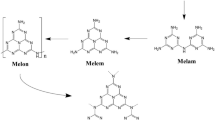Summary
Arcing of liquid carbon disulphide between graphite electrodes at − 80 °C produces elemental sulphur, carbon subsulphide (C3S2) having the structure S=C=C=C=S, and three other molecular species whose structure remains unassigned. The results were obtained by liquid chromatography (HPLC) equipped with a diode array detector. No polyynes were detected by HPLC although they form in other solvents by arcing graphite electrodes. It has been proposed that carbon subsulphide is obtained from the interaction between carbon monosulphide (C=S) formed from the plasmalysis of CS2 with C2 vapour released by the graphite electrodes. C3S2 has been identified in the arced CS2 solution from its characteristic FT-IR absorption bands at 2059 and 1019 cm−1. During warm-up from − 80 °C to room temperature, the red CS2 solution with C3S2 becomes dark brown and a polymeric product, polycarbon subsulphide (C3S2) X , separates. This polymerization reaction was followed spectroscopically for the first time showing that the disappearance of the characteristic C3S2 FT-IR bands are accompanied by the appearance of typical carbon subsulphide polymer bands. The FT-IR spectrum of the polymeric product confirms that it is essentially composed by (C3S2) X , although (CS2) X polymer is also identified as minor component. The FT-IR spectrum of the polymeric product does not appear significantly different from the spectra of the polymeric products obtained from photolysis, radiolysis, and sonolysis of CS2. The thermal behaviour of the polymeric product obtained from arcing CS2 has been studied by differential scanning calorimetry in static air. No melting point and other transitions are detected until 536 K; at 543 K a sharp exothermal transition occurs.







Similar content being viewed by others
References
Dunn A. D. (1989). Carbon Disulphide in Organic Chemistry. Ellis Horwood Ltd, Chichester
A. M. Smith, T. P. Stecher and L. Casswell, Astrophys. J. 242, 402 (1980).
J. D. Crovisier, D. Despois, D. P. Boklee-Morvan, P. Colom and G. Paubert, Icarus 93, 246 (1991).
N. Biver Science 275, 1915 (1997).
R. Meier and M. F. A’Hearn, Icarus 25, 64 (1997).
K. Zahnle, M. M. Mac Low, K. Lodders and B. Fegley, Geophys. Res. Lett. 22, 1593 (1995).
D. Heymann, F. Cataldo, M. H. Thiemens, R. Fokkens, N. M. M. Nibbering and R. D. Vis, Meteorit. Planet. Sci. 35, 355 (2000).
E. F. Van Dishoeck, G. A. Blacke, B. T. Draine and J. I. Lunine, in Protostars & Planets III E.H. Levy, J.I. Lunine and M.S. Matthews, eds. pp. 163-241 (Univ. of Arizona Press, Tucson, Arizona, USA, 1993).
E. G. Butcher, M. Aslop, J. A. Weston and H. A. Gebbie, Nature 199, 756 (1963).
A. G. Gaydon, G. H. Kimbell and H. H. Palmer, Proc. Roy. Soc. A279, 313 (1964).
F. Cataldo and D. Heymann, Eur. J. Solid State Inorg. Chem. 35, 619 (1998).
F. Cataldo, Inorg. Chim. Acta 232, 27 (1995).
J. J. Colman, X. Xu, M. H. Thiemens and W. C. Trogler, Science 273, 774 (1996).
F. Cataldo, Radiat. Phys. Chem. 58, 217 (2000).
F. Cataldo and D. Heymann, Radiat. Phys. Chem. 61, 115 (2001).
F. Cataldo, Carbon 42, 129 (2004).
F. Cataldo, Tetrahedron Lett. 45, 141 (2004).
F. Cataldo, Tetrahedron 60, 4265 (2004).
F. Cataldo, Fullerenes, Nanot. Carbon Nanostruct. 13, 21 (2005).
F. Cataldo, Polyhedron 23, 1889 (2004).
F. Cataldo, Int. J. Astrobiol. 3, 237 (2004).
E. Herbst, Annu. Rev. Phys. Chem. 46, 27 (1995).
V. D. Gordon, M. C. McCarthy, A. J. Apponi and P. Thaddeus, Astrophys. J. Suppl. 138, 297 (2002).
V. D. Gordon, M. C. McCarthy, A. J. Apponi and P. Thaddeus, Astrophys. J. Suppl. 134, 311 (2001).
H. Wang, J. Szczepanski, P. Brucat and M. Vala, Int. J. Quantum Chem. 102, 795 (2005).
H. Wang, J. Szczepanski, P. Brucat and M. Vala, Int. J. Quantum Chem. 102, 806 (2005).
H. Wang, J. Szczepanski, P. Brucat and M. Vala, J. Phys. Chem. A 107, 10925 (2003).
F. Cataldo (ed.) (2005) Polyynes: Synthesis Properties and Applications. CRC Press (Taylor & Francis Publishing Group, Boca Raton, FL).
A. O. Diallo, Compt. Rend. Acad. Sci. Paris C261, 5386 (1965).
W. Stadlbauer and Th. Kappe, Chem. Zeit. 101, 137 (1977).
A. O. Diallo, Compt. Rend. Acad. Sci. Paris C263, 1200 (1966).
R. Steudel, Z. Anorg. Allgem. Chem 361, 180 (1968).
E. K. Moltzen, K. J. Klabunde and A. Senning, Chem. Rev. 88, 391 (1988).
F. Cataldo, Fullerenes, Nanot. Carbon Nanostruct. 13, 21 (2005).
H. Von Hintenberger, J. Franzen and K. D. Schuy, Z. Naturforschung A 18, 1236 (1963).
T. Carofiglio, L. Pandolfo and G. Paiaro, Eur. Polym. J. 22, 491 (1986).
E. Whalley, Can. J. Chem. 38, 2105 (1960).
Author information
Authors and Affiliations
Corresponding author
Additional information
An erratum to this article can be found at http://dx.doi.org/10.1007/s10904-007-9104-9
Rights and permissions
About this article
Cite this article
Cataldo, F. Carbon Subsulphide Polymer (C3S2) X Formation by Arcing Carbon disulphide with the Submerged Carbon Arc. J Inorg Organomet Polym 16, 15–24 (2006). https://doi.org/10.1007/s10904-006-9031-1
Published:
Issue Date:
DOI: https://doi.org/10.1007/s10904-006-9031-1




